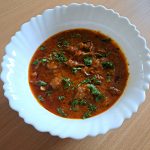How to make garam masala at home?

Garam masala is a blend of ground spices commonly used in Indian cuisine. The word “garam” means hot in Hindi and “masala” means spice, but in the context of garam masala, it refers to the warming effect of the spices rather than their heat. As it embodies the rich culinary traditions of India, its versatile and aromatic nature has also led to its incorporation into international cuisine, bringing a taste of Indian spices to kitchens around the world. Achieving the perfect homemade garam masala starts with the right ratios, impeccable roasting, and skillful blending. Precision in roasting these spices releases their essential oils, enhancing flavour. A meticulous blend ensures every spoonful imparts warmth and depth to your dishes.
Garam masala typically includes a combination of warm and aromatic spices. The exact composition can vary based on regional preferences, family traditions, and individual tastes. Common spices found in the blends include cinnamon, cardamom, cloves, cumin, coriander, black pepper, and nutmeg.
These spices are usually roasted and ground to a fine powder. Keep in mind that there are many regional variations of garam masala, and you may find different combinations of spices depending on the specific culinary tradition. Each spice contributes its unique flavour profile, aroma, and characteristics, collectively creating a well-balanced and complex spice blend.
Importance of each spice:
Understanding the importance of each spice allows you to tailor garam masala to your preferences and adapt it to specific recipes.
Cinnamon: Adds a sweet and warm flavour. Imparts a subtle sweetness and a hint of woody aroma.
Cardamom: Offers a floral, citrusy, and slightly spicy flavour. Adds a bright and refreshing note to the blend.
Cloves: Contributes a pungent, sweet, and slightly bitter taste. It adds depth and a warm, aromatic quality.
Cumin: Provides an earthy, nutty, and slightly smoky flavour. Enhances the savoury and robust aspects of the blend.
Black Pepper: Adds heat and a pungent, sharp flavour. Provides a spicy kick to the overall blend.
Nutmeg: Imparts a warm, sweet, and slightly nutty flavour. It adds a layer of richness and depth to the blend.
Star anise: Its sweet and aromatic qualities can complement the other spices, enhancing the overall complexity of the blend.
Nutmeg: Nutmeg has a warm, sweet, and nutty flavour. It contributes a rich and aromatic fragrance to the spice blend.
Coriander: Coriander seeds help in balancing the stronger, more pungent flavours of spices like cloves and black pepper found in garam masala. They contribute a mild element that prevents any single spice from overpowering the entire blend. Coriander seeds are aromatic and release a fragrant essence when toasted or ground.

Adding garam masala towards the end.
Many chefs and home cooks prefer to sprinkle garam masala as a finishing touch to impart a burst of fragrance. This allows the volatile aromatic compounds in the spices to be preserved, enhancing the overall aroma and flavour of the dish.
Adding garam masala earlier in cooking.
There are instances where garam masala can be incorporated earlier in the cooking timeline. In some recipes, especially those with longer cooking times, it may be added earlier to allow its flavours to meld with the other ingredients. Roasting garam masala along with other spices at the beginning of the cooking process can deepen its flavours and infuse the dish with a robust, well-integrated taste.
When to add garam masala in cooking?
The choice of when to add garam masala often depends on the cook’s preference and the specific requirements of the dish. As a general guideline, if you want a more pronounced and distinct garam masala flavour, adding it towards the end might be preferable. On the other hand, incorporating it earlier can lead to a more subtle integration of its flavours into the entire dish. Sprinkling garam masala over a finished curry or stew just before serving can provide a delightful and aromatic lift.

Know about Ceylon and Cassia cinnamon
Ceylon cinnamon and Cassia cinnamon are two different types of cinnamon with distinct flavour profiles, appearances, and nutritional compositions. All types of cinnamon contain a compound known as coumarin, which is known to be harmful in large amounts. Ceylon cinnamon has much less coumarin than cassia cinnamon. If you are concerned about coumarin, Ceylon cinnamon is a safer option for your spice rack.
Ceylon cinnamon
Ceylon cinnamon is native to Sri Lanka and is often considered to be of higher quality. It is obtained from the inner bark of Cinnamomum verum trees. Ceylon cinnamon has a lighter, brighter and spicier flavour than cassia cinnamon. Ceylon cinnamon has a lighter colour, often tan to light brown, and a thin, delicate texture that can be easily crumbled.
Cassia cinnamon
Cassia cinnamon, on the other hand, comes from the bark of Cinnamomum cassia trees. It is commonly found in China, Indonesia, and other Southeast Asian countries. It has a darker reddish-brown to dark brown and is much thicker and harder to break apart with the rough bark still attached. Cassia cinnamon has a stronger, spicier, and slightly bitter taste. It is often described as being more intense and less sweet than Ceylon cinnamon. Cassia cinnamon is more widely available and tends to be less expensive.
Garam masala is a common spice used in many dishes in Indian cooking. A few are Chicken chukka, Pepper chicken, Egg keema masala and many more.


Here’s a basic recipe for homemade garam masala:
How to make garam masala at home?
Equipment
- Blender or a food processor
Materials
- 3 tbsp coriander seeds
- 1 tbsp cardamom
- 1 tbsp cloves
- 1 tbsp Ceylon cinnamon approximately 4 to 5, 1 inch pieces
- 1 tbsp pepper
- 1 tbsp cumin
- 1 tbsp fennel
- 1 black cardamom
- 2 maces (Javithri)
- 4- star anise
- 1 dried kashmiri chilly or dried red chilly optional
- 3 bay leaves (Tej patta)
- ½ tsp nutmeg powder
Instructions
- Heat a dry pan over medium heat. Add the coriander seeds and dry roast them, stirring frequently, until they become fragrant. This usually takes less than a minute. Be cautious not to burn them.
- Remove from the pan and let them cool to room temperature.
- In the same pan, add cardamom, cloves and cinnamon and repeat the same process.
- Once roasted transfer them to a plate and let them cool to room temperature.
- In the same pan, add pepper, cumin, fennel, black cardamom, mace, star anise, dried kashmiri chillies, bay leaves and nutmeg. If you are using ground nutmeg, there is no need to add at this stage.
- Adding Kashmiri chilly is purely optional as it is added for some extra heat.
- Dry roast them and transfer them to a plate to cool.
- Once cooled, add them to a blender and grind to a fine powder. Don´t over-grind them as this can affect the flavour and taste of garam masala.
Notes


1 thought on “How to make garam masala at home?”